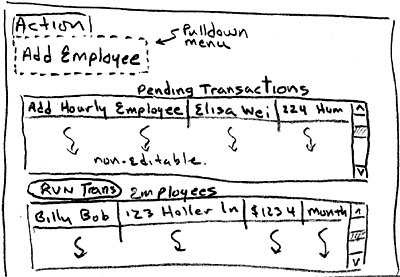The Interface
| Figure 38-1 shows the general idea for the UI that we'll build. The menu named Action contains a list of all the supported actions. Selecting an action opens an appropriate form for creating the selected action. For example, Figure 38-2 shows the form that appears when Add Employee is selected. For the time being, Add Employee is the only action we're interested in. Figure 38-1. Initial payroll user interface Figure 38-2. Add Employee transaction form Near the top of the Payroll window is a text box labeled Pending Transactions. Payroll is a batch system. Transactions are entered throughout the day but are not executed until night, when they are all executed together as a batch. This top text box is a list of all the pending transaction that have been collected but not yet executed. In Figure 38-1 we can see that there is one pending transaction to add an hourly employee. The format of this list is readable, but we'll probably want to make it look prettier down the road. For now, this should do. The bottom text box is labeled Employees and contains a list of employees who already exist in the system. Executing AddEmployeeTransactions will add more employees to this list. Again, we can imagine a much better way to display the employees. A tabular format would be nice. There could be a column for each bit a data, along with a column for the date of the last paycheck, amount paid to date, and so on. Records for hourly and commissioned employees would include a link to a new window that would list their time cards and sales receipts, respectively. That will have to wait, though. In the middle is a button labeled Run Transactions, which does just as it suggests. Clicking it will invoke the batch, executing all the pending transactions and updating the employee list. Unfortunately, someone will have to click this button to initiate the batch. This is a temporary solution until we create an automatic schedule to do it. |
EAN: 2147483647
Pages: 272

